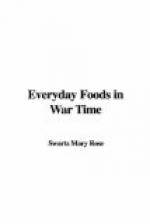There is a further significance for fruits and vegetables in their contribution to the diet of the growth-promoting, health-protecting vitamines. That the presence of fruits and vegetables in the diet is a safeguard against scurvy is well known, though the full scientific explanation is not yet ours. That the leaf vegetables (spinach, lettuce, cabbage, and the like) contain both the vitamines which are essential to growth in the young and to the maintenance of health in the adult seems assured, and gives us further justification for emphasis on green vegetables in the diet of little children, when properly administered—i.e., always cooked, put through a fine sieve, and fed in small quantities.
Aside from being valuable for regulation of the bowels, for mineral salts, and vitamines, to say nothing of more or less fuel value, fruits and vegetables give zest to the diet. The pleasant acidity of many fruits, their delicate aroma, their beautiful form and coloring, the ease of preparing them for the table, are qualities for which we may legitimately prize them, though we may not spend money for them until actual nutritive requirements are met. Dr. Simon Patten, in his New Basis for Civilisation, ably expresses the value of appetizers: “Tomatoes, the hothouse delicacy of the Civil War time, are doing now what many a bloody revolution failed to accomplish; they have relieved the monotony of the salt pork and boiled potatoes upon the poor man’s table. The clear acid flavor of the canned vegetable lightens ugly heaviness and adds tonic gratifications for the lack of which men have let each other’s blood.”
As already remarked, those who have plenty of highly flavored meat are apt to be satisfied by it or to demand stronger flavors (coffee, catsup, pickles, and tobacco) than those found in fruits and vegetables. They are also apt to spend so much money on meat that they have none left to buy what seem to them unimportant items in the diet, and to have a much less wholesome diet than they might have for the same money. Studies of expenditures in many families show that a good rule to insure a well balanced diet is to spend no more money for meat than one does for fruit and vegetables. Also, it is well to remember that vegetables are usually cheaper than fruits and that dried ones may largely take the place of canned or




